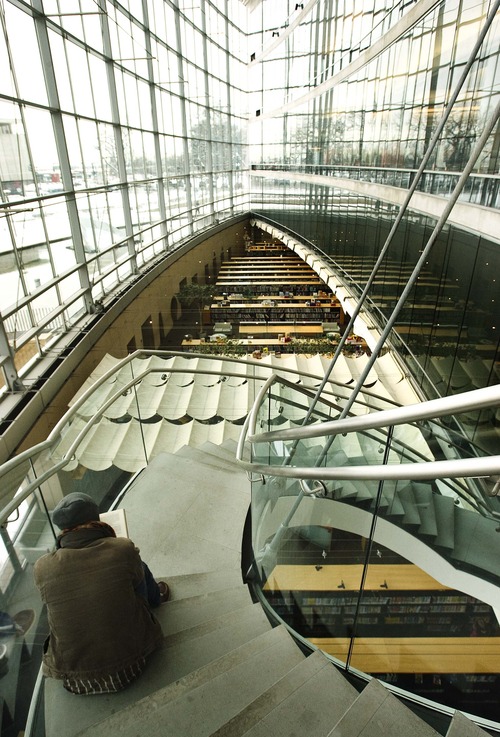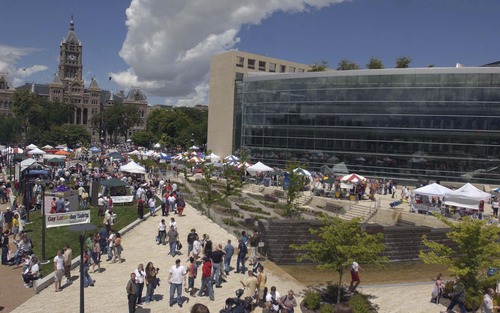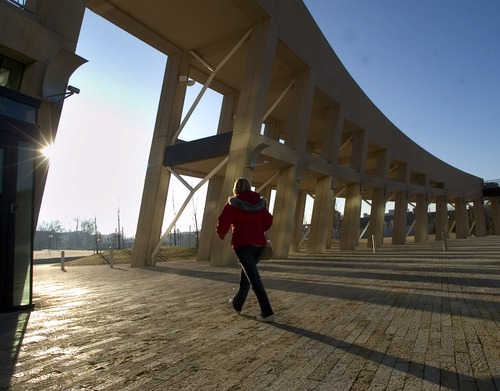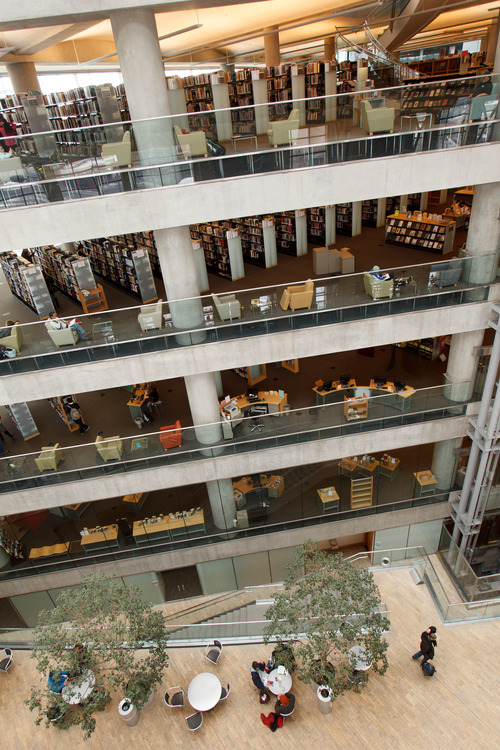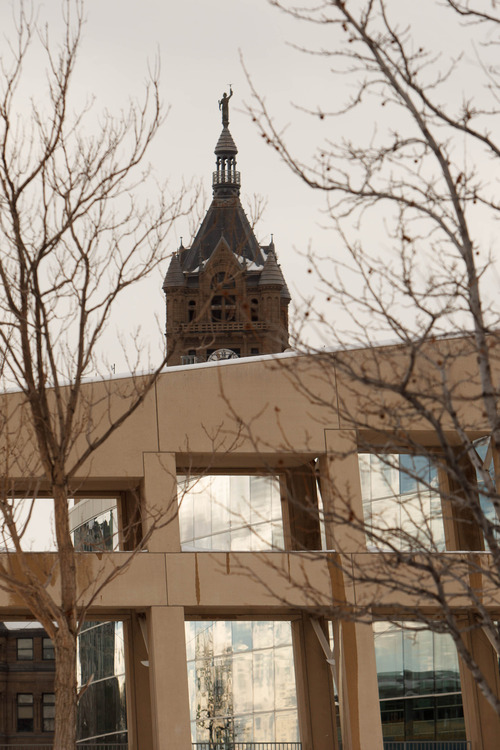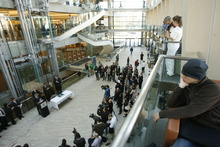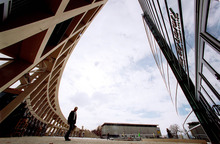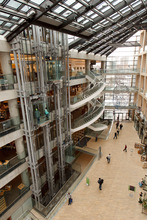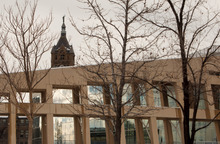This is an archived article that was published on sltrib.com in 2013, and information in the article may be outdated. It is provided only for personal research purposes and may not be reprinted.
Salt Lake City got more than a place for books when its new downtown library opened 10 years ago.
It cost taxpayers $84 million, but residents weren't disappointed with what has become an iconic gathering place and a source of community pride.
The building helps define Utah's capital city and, some say, it started a new architectural era in Salt Lake City.
The bold design by Boston-based architect Moshe Safdie was embraced as a work of wonder by Salt Lakers when it opened in February 2003. A decade on, it still pulls residents and visitors into its soaring atrium, provides reading areas with stunning views of the Wasatch Mountains, and offers a mid-block plaza that plays host to community events as well as casual passersby.
Library officials estimate that 1 million people pass through its doors every year to log on to its public computers, check out books and DVDs, look over periodicals and maps or simply ride the glass elevators, get coffee and hang out.
But that's only part of the story.
"This is more than a place for a repository of books," said Stephen Goldsmith, professor of architecture and planning at the University of Utah. "It has raised the community self-esteem."
Residents, he said, are known to tell visitors, "Oh, you have to see our library."
Goldsmith was Salt Lake City's planning director during the final run-up to construction. The design of the Main Library signaled a new era of architecture in Salt Lake City, he said.
"The aspiration for design excellence was set in motion by Moshe Safdie's library," Goldsmith noted. "It's a point of reference."
The landmark is a key element in bringing people downtown, said Lisa Sewell, executive director of the Utah Arts Festival. The annual summer celebration moved to Library Square in 2003. And it's been a popular venue.
"It's been great as a community gathering space," she said. "We've been lucky in having a community that protects Library Square."
In early 2009, Mayor Ralph Becker introduced plans to build a new Public Safety Building on the east side of Library Square. But a vociferous public outcry helped him change his mind. In June 2009, Becker said he would leave Library Square as it is.
Nonetheless, the library and its grounds do inform the design of the new Public Safety Building, which is going up on the east side of 300 East. From the inside, its sweeping windows frame Library Square and the surrounding cityscape.
"The library raised the bar for all architecture in Salt Lake City. What's a great building now in Salt Lake City? It's the library," said architect David Brems, of GSBS Architects, who designed the Public Safety Building. "It's unsaid, but [planners and designers] want their buildings to be at least that good. That set the stage for the Public Safety Building."
The structure "transcends" its function as a library, Brems said. "It's what we call 'place-making,' " he said of the building's allure.
And it does attract everyone from college students seeking a bright place to study to homeless people looking to get warm as well as folks who don't have any other access to the Internet. Its auditorium attracts movie- and conference-goers. It's a place for businessmen to meet, parents to take their children and high schoolers to escape.
Hassan Ali is a 15-year-old Granger High student who hops on TRAX once or twice a week to visit the library. A recent immigrant from Kenya, he uses library computers to keep up with international soccer. And he just likes the feel of the place.
"It's beautiful," he said. "The architecture is very good."
Safdie's design was selected through a competition, but the final plans also reflect input from city officials and user groups, the architect said.
Prior to that, Safdie had designed one other library. In Vancouver, British Columbia, he employed what he called the "urban room" design, recognizable by its large atrium.
Successful architecture draws people in and engages them, Safdie said. When Salt Lake City officials visited Vancouver, they liked what they saw, he said. "It was full of life, not just a library."
Former library director Nancy Tessman helped guide the design process by detailing to Safdie how she wanted it to function, the architect recalled.
"It was a fascinating evolution," he said of the design process. "Nancy Tessman was an extraordinary leader."
Many were skeptical that such a library could be built in Salt Lake City, known for its utilitarian architecture, Safdie said.
"People were cynical because to achieve something like this requires commitment on many levels," he said. "The outcome at the end is only as good as the client and the city planning department and the groups who support it. This is a community triumph."
Ten years since its opening, it's hard to imagine Salt Lake City without its downtown public library. That, say the experts, is the mark of good architecture.
Anniversary activities
Friday • The Children's Department will host 10 story times, beginning at 9:45 a.m., continuing every 45 minutes throughout the day, culminating in a birthday sing-along at 4:30 p.m.
Saturday • The Friends of The City Library's Members Only book sale begins at 9 a.m. Memberships will be available at the door. A celebration of Chinese New Year begins at 2 p.m., complete with a dragon dance. Also, the public is invited to record their library experiences on video. The vignettes will be used to share the story of the library's impact on the community during the rest of the year.
All month • Visitors are encouraged to pick up a Main Library guide and take tours of the building.
O For more on events surrounding the 10-year celebration of the Main Library, visit > http://www.slcpl.org Library trivia
In 2012 the library circulated 1,858,003 books, 1,203,896 DVDs, 482,718 CDs and other audio visual materials and 69,907 e-books.
The three most popular circulating materials since February 2010 (the last time the library changed check-out monitoring systems): "The Hunger Games," "Mockingjay" and "Catching Fire," collectively known as the "Hunger Games Trilogy" by Suzanne Collins. People magazine ranks a close fourth.
The three most popular circulating e-book titles: "The Hunger Games," "Mockingjay" and "Catching Fire." "Miss Peregrine's Home for Peculiar Children" ranks a distant fourth.
Square feet of glass in the building: 176,368 or, as the library brochure puts it, "enough to cover three football fields.
The name of the sculpture suspended from the library's Urban Room: "Psyche," by Boston artists Ralph Helmick and Stu Schechter, consisting of almost 1,500 individual pieces depicting books and butterflies, each containing words across 20 languages gathered from the United Nations' Universal Declaration of Human Rights.
The fourth floor is home to a beehive.
The bottom floor houses a small but up-to-date staff gym.
In case of an earthquake, bridges connecting all floors are loose at the ends and ready to slide on plates.
Fixtures were shipped in from Denmark, England, Italy and Mexico; marble is from China and other materials and building techniques are from Israel.
Sources: Salt Lake City Public Library System, library administration


